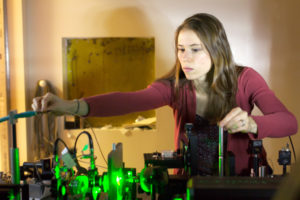Scientists Discover Glittery Diamonds Can Shine New Light on Understanding How the Brain Works
While most people see glamour or wealth in a glittery diamond, Hertz Fellow Jenny Schloss sees a pathway to understanding how the brain works.
Schloss is pioneering a new process of using synthetic diamonds to detect the miniscule magnetic fields generated by neural signals, at high resolution, down to individual neurons. It has the potential to revolutionize methods of measuring neural activity across wide-ranging disciplines, including biophysics and pharmacology, and contribute to a better understanding of the development of neurons over time. One promising direction in medicine is with neurodegenerative diseases like multiple sclerosis, where neuroscientists could correlate real-time changes in the magnetic signals from patients’ neurons with the progression of the disease.
“We’re developing a new technique that can sense neural activity and also be used over long durations without harming the samples,” Schloss said. “One way to do that is by sensing the magnetic field because it extends outside the neuron and can be detected by an external sensor.”

Schloss, a PhD candidate at MIT, and her team at Harvard University are particularly interested in nitrogen-vacancy centers (NVs), nanoscopic defects in diamonds that are manipulated by the tiny magnetic fields generated by neural activity.
“Nitrogen vacancies are a special type of defect,” Schloss said. “They have spin, so they’re sensitive to magnetic fields, and they glow red when you shine light on them, brighter or dimmer depending on the magnetic field. We collect light from more than a billion NVs in a single diamond.”
Using microwave radiation and a laser to manipulate the NVs’ quantum spin states, Jenny and her colleagues collect fluorescent light from the NVs. When a neuron fires, the researchers detect blinking in this light and can read the magnetic signal of the neurons from the change in the light collected. The research is described in a recent paper published in the journal Proceedings of the National Academy of Sciences.
Since nobody had ever seen neural signals using diamonds before, the researchers selected the most basic neurons that would give them the largest and most easily identifiable signal: a dissected squid neuron and later, an entire marine worm, which were placed on top of diamond and stimulated through electric shock.
“For this first demonstration, we asked, ‘Can you detect a signal from a neuron using diamond?’ The answer is yes,” Schloss said. “And you can also learn some interesting things about the neuron that you might not otherwise have been able to see.”
A huge advantage of using diamonds over traditional methods of measuring neural activity, such as patch clamping, where a probe is used to puncture a neuron and registers the change in voltage, is that it’s much less invasive and doesn’t damage the neuron, Schloss explained.
Schloss said the next step in her team’s research is to move to smaller, cultured mammalian neurons and make wide-field magnetic images of activity.
“There’s a lot of engineering between getting a first signal and developing a widely applicable tool,” Schloss said. “We next need to demonstrate that this is a powerful technique not just for giant axons but for common systems currently being studied in active neuroscience research.”
Schloss’ background in quantum mechanics has helped her understand the physics of nitrogen-vacancy centers, which are frozen in place by the diamond lattice and are analogous to cold atoms. Born and raised in Concord, Mass., Schloss earned her undergraduate degree in physics at Oberlin College in Ohio and came back to her home state to pursue quantum physics at MIT. She’ll earn her PhD, likely next year, from MIT, but spends most of her time working under Ronald Walsworth in the Center for Brain Science at Harvard.
“My ultimate goal is to see this tool applied broadly,” Schloss said. “I hope it will be adopted and used in all types of studies. I’m particularly excited about imaging neurons over long durations to study neural development. There’s a lot that’s still unknown about that process, and ultimately I think our tool could play a role in answering some big questions about the brain.”